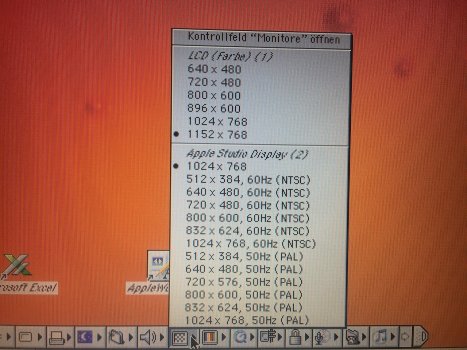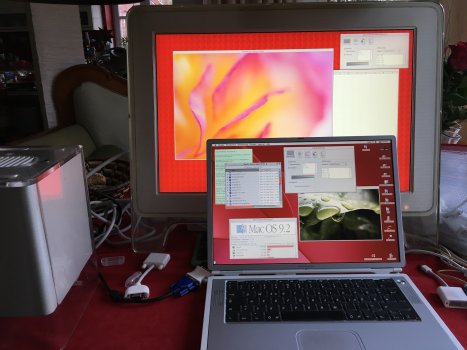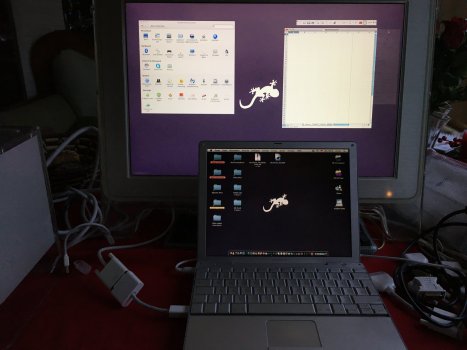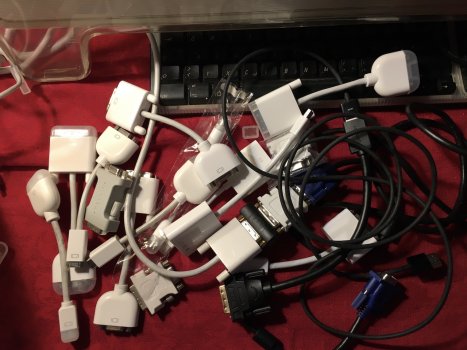Just thought I'd make a list of ADC monitors, as well as adapters and other peripherals. Just for the heck of it really. 
Monitors
Notes:
Adapters and Cables
Graphics Cards
Notes:
KVM Switches
History of Major Updates
Monitors
| Manufacturer | Model | Size | Panel (Type) or Tube (Type) | Resolution | PPI | Intro or Release |
| Apple | Studio Display [1] | 15" | LG.Philips (TN) | 1024×768 | 85.33 | 2000.07.19 |
| Apple | Studio Display (CRT) | 17" | NEC-Mitsubishi (DiamondTron) | 1600×1200 (max) | ? | 2000.07.19 |
| Apple | Studio Display | 17" | Samsung (IPS) | 1280×1024 | 96.42 | 2001.05.21 |
| Apple | Cinema Display | 20.1" | IDTech IAWS64C (IPS) | 1680×1050 | 99.06 | 2003.01.28 |
| Apple | Cinema Display [2] | 22" | LG.Philips LM220W1-A2MN (IPS) | 1600×1024 | 86.35 | 2000.07.19 |
| Apple | Cinema HD Display | 23" | LG.Philips LM230W01-A2 (IPS) | 1920×1200 | 98.44 | 2002.03.20 |
| Formac | gallery 1740 [3] | 17.4" | MVA | 1280×1024 | 94.21 | 2001.10.16 |
| Formac | gallery 2010 Platinum [3] | 20.1" | MVA | 1600×1200 | 99.50 | 2002.09.17 |
Notes:
- The 15" Studio Display was first introduced on 1998.03.17, with DB-15. It was first updated to use VGA on 1999.01.05 and updated again to use DVI on 1999.12.02.
- The 22" Cinema Display was first introduced on 1999.08.31, with DVI.
- The Formac gallery 1740 and 2010 were also available with DVI.
Adapters and Cables
| Manufacturer | Model | Input | Output | Works with 17" CRT | Intro or Release |
| Apple | ADC to DVI Adapter | ADC | DVI | – | ? |
| Apple | DVI to ADC Adapter | DVI | ADC | no | 2002.04.29 |
| Belkin | Apple Monitor Adapter | ADC | DVI | – | ? |
| Dr. Bott | ADC Extension | ADC | ADC | no | 2001.11.19 |
| Dr. Bott | ADC Extension Pro | ADC | ADC | no | 2003.01.07 |
| Dr. Bott | DVIator | DVI | ADC | no | 2001.06.12 |
| Dr. Bott | DVI Extractor | ADC | DVI | – | 2001.11.19 |
| Dr. Bott | DVI Extractor II | ADC | DVI | – | 2002.11.05 |
| Dr. Bott | VGAtor | VGA | ADC | no | 2004.05.13 |
| Dr. Bott | VGA Extractor | ADC | VGA | – | 2002.03.08 |
| Gefen | DVI to ADC Conversion Box | DVI | ADC | no (one report says yes) | 2001.02.18 |
| Gefen | VGA to ADC Conversion Box | VGA | ADC | no | 2002.03.11 |
| New Motion | DVI-ADC Adapter | DVI | ADC | ? | 2001.??.?? |
| New Motion | DVI to ADC Conversion Box | DVI | ADC | ? | 2001.??.?? |
Graphics Cards
| Manufacturer | Model | Memory (MB) | Outputs | OS 9 | Shipped in | Intro or Release |
| ATI | Rage 128 Pro [1] [2] | 16 | ADC | VGA | yes | PM G4 Cube/GE | 2000.07.19 |
| ATI | Radeon [3] | 32 | ADC | VGA | yes | PM G4 Cube/GE; Apple Store | 2000.09.13 |
| ATI | Radeon 7500 | 32 | ADC + VGA | yes | PM G4 QS | 2002.01.28 |
| ATI | Radeon 9000 Pro | 64 | ADC + DVI | yes | PM G4 MDD/FW800/2003 | 2002.08.13 |
| ATI | Radeon 9600 Pro | 64 | ADC + DVI | no | PM G5 | 2003.06.23 |
| ATI | Radeon 9600 XT | 128 | ADC + DVI | no | PM G5 June/Late 2004 | 2004.06.09 |
| ATI | Radeon 9700 Pro | 128 | ADC + DVI | no | PM G4 FW800 | 2003.01.28 |
| ATI | Radeon 9800 Pro | 128 | ADC + DVI | no | PM G5 | 2003.06.23 |
| ATI | Radeon 9800 Pro Special Edition | 256 | ADC + DVI | no | Retail | 2004.02.08 |
| ATI | Radeon 9800 XT | 256 | ADC + DVI | no | PM G5 June/Late 2004 | 2004.06.09 |
| ATI | Radeon X800 XT | 256 | ADC + DL-DVI | no | Retail | 2005.01.05 |
| ATI | Radeon X850 XT | 256 | ADC + DL-DVI | no | PM G5 Early 2005 | 2005.06.27 |
| NVIDIA | GeForce2 MX | 32 | ADC | VGA | yes | PM G4 Cube/DA | 2001.01.09 |
| NVIDIA | GeForce2 MX with TwinView | 64 | ADC + VGA | yes | PM G4 QS | 2001.07.18 |
| NVIDIA | GeForce3 | 64 | ADC | VGA | yes | PM G4 DA/QS | 2001.02.21 |
| NVIDIA | GeForce4 MX | 64 | ADC + VGA | yes | PM G4 QS 2002/ED/MDD/FW800 | 2002.01.28 |
| NVIDIA | GeForce4 Ti4600 | 128 | ADC + DVI | yes | PM G4 QS 2002/MDD/FW800/ 2003 | 2002.02.04 |
| NVIDIA | GeForce FX 5200 Ultra | 64 | ADC + DVI | no | PM G5 | 2003.06.23 |
Notes:
- Outputs separated by | means: only one of them can be active at once (single-head).
- Outputs separated by + means: both can be active at once and display two independent images (dual-head).
- The "OS 9" column indicates whether a GPU has full driver support, i.e. 2D acceleration, 3D acceleration, resolution and refresh rate switching etc. in Mac OS 9.x.
- The ATI Rage 128 Pro will not output resolutions higher than 1600×1024 via ADC or DVI once Mac OS (tested with 8.6, 10.0, Server 1.2v3) boots. See here and here for details.
- The ATI Rage 128 Pro was first offered in December 1999, with DVI and VGA outputs.
- The original ATI Radeon (later renamed to Radeon 7200) was also available as a retail product, with DVI, VGA and S-Video outputs.
KVM Switches
| Manufacturer | Model | Inputs | Output(s) | Works with 17" CRT | Intro or Release |
| Compucable | Power Reach ADC/DVI KVM | ADC + DVI | ADC | ? | ? |
| Dr. Bott | MoniSwitch ADC | 2× ADC | ADC | no | 2002.10.14 |
| Dr. Bott | MoniSwitch Pro ADC | 4× ADC | ADC | no | 2004.06.02 |
| Gefen | 2-Port DVI ADC KVM Switch | 2× DVI | ADC | no | ? |
| Gefen | 4-Port DVI ADC KVM Switch | 4× DVI | ADC, DVI | no | 2004.??.?? |
History of Major Updates
- 2021.08.09: Initial version created.
- 2021.08.10: Apple monitors and graphics cards added.
- 2021.08.12: Belkin adapter added; tables tidied up; KVMs moved to separate section.
- 2021.08.14: Intro date for GeForce2 MX and Radeon corrected.
- 2021.08.16: Some notes added.
- 2023.06.07: New Motion DVI-ADC Adapter and DVI to ADC Conversion Box added.
- 2023.06.08: Panels used in ADC LCDs added (where known).
- 2023.06.09: Tidied up some tables; added notes on ATI Rage 128 Pro and original Radeon.
- 2024.02.02: Added "OS 9" column for GPUs indicating full driver support including 3D acceleration etc.; added more info on ATI Rage 128 Pro; added info on whether a GPU's outputs can both be active at once and show different images.
- 2024.08.17: Added Compucable Power Reach ADC/DVI KVM. No datasheet, info on 17" CRT compatibility or release date though.
Last edited:





